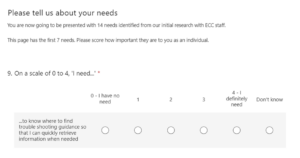Identifying user needs
As user researchers for Essex County Council, we conduct research with residents and staff to provide insight that informs meaningful change and improvement to council services.
One of the responsibilities we have is to identify the different needs of our users so that we can build better services that meet and exceed expectations.
A user need is something that a person has to get done. It is for us at ECC to make sure that the services we deliver satisfy their needs and create the right outcome for them.
Once we’ve conducted enough research to define our users’ needs, we work together in Service Transformation to articulate these as concise written statements using the following syntax:
As a… [specific user role e.g. an Essex resident)
I need to… [the task that they have to do]
So that… [the goal that they want to achieve]
Validating user needs
For most cases, we will have established our users’ needs through immersive, in-depth qualitative research activities such as interviews, workshops and usability testing.
However, the smaller sample of participants associated with these methods can risk their feedback being unrepresentative of the overall user base and create situations where only the squeaky wheel gets the grease. By this, we mean that only the loudest voices receive attention and the opinions of other users are not heard and can become overlooked.
By validating user needs at scale to a wider audience, we reduce this risk and ensure our research insights are more robust and representative.
How we can do this
A survey is a quick way to achieve scale and has been effective at providing us with quantitative data to corroborate the user needs we’ve identified from qualitative insights.
We did this most recently for some research focused on one of ECC’s internal services. This is a platform used by staff to access IT support when they experience technical difficulties such as malfunctioning hardware or unresponsive software applications.
We designed a survey that presented each user need statement identified from one-to-one interviews with ECC staff who had recently used the service and asked respondents to review and score their importance using a scale ranging from 0 – I have no need to 4 - I definitely need.

115 staff responded to the survey and based on their average scores, we could categorise each user need statement as either Very High, High, Medium or Low in priority to them.
Below are some examples documented in the backlog we produced for every statement.

What next?
By having this level of validation from quantitative data, it strengthened the qualitative insights, empowered stakeholders to prioritise the user needs and enabled us to make evidence-based recommendations on how to improve the service’s user experience.
This has provided the project team with robust, validated evidence to underpin the next stages of design, development and iteration for this digital service.
Leave a comment